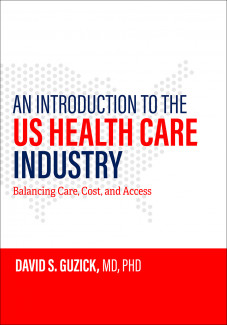
Johns Hopkins UniversityEst. 1876
America’s First Research University
Now Browsing:
The US Health Care Industry and COVID-19

Although the novel coronavirus SARS-CoV-2 contains only 15 genes in comparison with 30,000 in the human genome, it has been a powerful adversary. Indeed, the core paradox of U.S. health care – that our nation has the worst population health among high-income countries despite spending about twice as much per person on health care – has been accentuated by the COVID-19 pandemic. The U.S. has state-of-the-art biomedical science and technology, extraordinary medical training that serves as an international model, advanced hospitals with the latest in ICU design and technology, workflows designed to meet the highest safety standards, and sophisticated digital medical record and communication platforms. And yet, our nation was ill-prepared for the virus, as evidenced by the inability to curb spread of the virus in its early stages in comparison with peer nations internationally, and by rates of cases and deaths that continue to be among the highest in the world.
The same political, cultural, historical and economic forces that shaped the U.S. health care industry, described in detail in An Introduction to the US Health Care Industry: Balancing Care, Cost and Access, is now shaping our nation’s response to COVID-19. As occurred frequently in the evolution of US health care, addressing the COVID-19 pandemic has been seen through a decentralized, market-driven lens. While this may seem attractive in theory, it proved to be extremely problematic in practice. Public health controls were delayed and fragmented. Diagnostic testing was initially flawed at the federal (CDC) level, and then inefficiently and unevenly developed and deployed in localities and health systems. The distribution of personal protective equipment (PPE) to needed health facilities was initially impeded by an imperfect marketplace in which prices were bid up by states competing with one another for PPE items, and in which there was a lack of clarity about federal-vs-state ownership of PPE. As the pandemic has now spread throughout the US, the lack of national planning and inadequate use of the Defense Production Act has led to continued shortages of PPE. The explosive growth in COVID-19 cases in affected regions, and the resulting need for diagnostic testing, ICU beds and ventilators, has often overwhelmed the capacities of even well-equipped, elite hospitals and health systems. The fear of COVID-19 infection in viral “hotspots” led people with symptoms of acute medical conditions to stay at home instead of visiting an emergency room, adding to higher-than-expected death rates. Finally, conflicting public messages combined with the politicization of preventive practices such as wearing a mask and avoiding large gatherings, especially indoors, has consistently resulted in marked increases in cases and deaths after premature “re-openings” of local economies.

In An Introduction to the US Health Care Industry, I argue that US health care is an industry comprised of a loose federation of stakeholders. Each of these stakeholders (doctors, hospitals, nursing homes, insurance companies, pharmaceutical companies, device manufacturers) has pursued its own goals across time, governed in principle by the “invisible hand” of a market that is imperfect, leading to imbalances in care, cost and access. When I wrote about the future of this internationally unique health care industry, the COVID-19 pandemic had not yet commenced; little did I know that we would soon be living through a dark example of this future.
Many of the central themes of An Introduction to the US Health Care Industry are playing out in real-time by the evolving pandemic. For example:
Order An Introduction to the US Health Care Industry: Balancing Care, Cost, and Access – published on October 13, 2020 – at the following link: https://jhupbooks.press.jhu.edu/title/introduction-us-health-care-industry
David S. Guzick, MD, PhD, a former senior vice president for health affairs and the president of UF Health, is a professor of obstetrics-gynecology and health services research and management at the University of Florida. He is the author of An Introduction to the US Health Care Industry: Balancing Care, Cost, and Access.

The same political, cultural, historical and economic forces that shaped the U.S. health care industry, described in detail in An Introduction to the US Health Care Industry: Balancing Care, Cost and Access, is now shaping our nation’s response to COVID-19. As occurred frequently in the evolution of US health care, addressing the COVID-19 pandemic has been seen through a decentralized, market-driven lens. While this may seem attractive in theory, it proved to be extremely problematic in practice. Public health controls were delayed and fragmented. Diagnostic testing was initially flawed at the federal (CDC) level, and then inefficiently and unevenly developed and deployed in localities and health systems. The distribution of personal protective equipment (PPE) to needed health facilities was initially impeded by an imperfect marketplace in which prices were bid up by states competing with one another for PPE items, and in which there was a lack of clarity about federal-vs-state ownership of PPE. As the pandemic has now spread throughout the US, the lack of national planning and inadequate use of the Defense Production Act has led to continued shortages of PPE. The explosive growth in COVID-19 cases in affected regions, and the resulting need for diagnostic testing, ICU beds and ventilators, has often overwhelmed the capacities of even well-equipped, elite hospitals and health systems. The fear of COVID-19 infection in viral “hotspots” led people with symptoms of acute medical conditions to stay at home instead of visiting an emergency room, adding to higher-than-expected death rates. Finally, conflicting public messages combined with the politicization of preventive practices such as wearing a mask and avoiding large gatherings, especially indoors, has consistently resulted in marked increases in cases and deaths after premature “re-openings” of local economies.

In An Introduction to the US Health Care Industry, I argue that US health care is an industry comprised of a loose federation of stakeholders. Each of these stakeholders (doctors, hospitals, nursing homes, insurance companies, pharmaceutical companies, device manufacturers) has pursued its own goals across time, governed in principle by the “invisible hand” of a market that is imperfect, leading to imbalances in care, cost and access. When I wrote about the future of this internationally unique health care industry, the COVID-19 pandemic had not yet commenced; little did I know that we would soon be living through a dark example of this future.
Many of the central themes of An Introduction to the US Health Care Industry are playing out in real-time by the evolving pandemic. For example:
- The impact of politics on health care and health;
- The often unaligned effects of public health measures, personal behaviors and biomedical science on population health status;
- The inability of a market economy to address a public health crisis without government intervention;
- The function – and dysfunction – of the interface between government and a market economy’s “invisible hand” in allocating resources such as diagnostic testing and personal protective equipment, and in fostering contact tracing and telehealth;
- The role of innovation in the development of vaccines and therapeutics;
- The impact of large-scale losses of employer-based health insurance;
- The inequality of disease and mortality across diverse populations and income groups, and the impact of the pandemic in widening the already significant inequality in income, wealth and health;
- The economic value of life, as implicitly calculated through the trade-off between incremental GDP against incremental disease and death.
Order An Introduction to the US Health Care Industry: Balancing Care, Cost, and Access – published on October 13, 2020 – at the following link: https://jhupbooks.press.jhu.edu/title/introduction-us-health-care-industry
David S. Guzick, MD, PhD, a former senior vice president for health affairs and the president of UF Health, is a professor of obstetrics-gynecology and health services research and management at the University of Florida. He is the author of An Introduction to the US Health Care Industry: Balancing Care, Cost, and Access.

Login to View & Leave Comments
Login to View & Leave Comments


